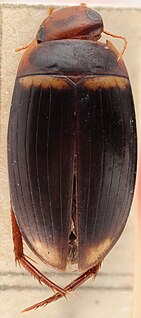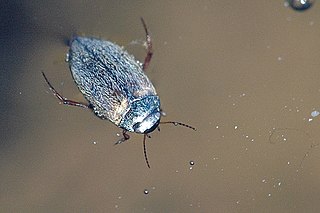| Nebrioporus | |
|---|---|
| Scientific classification | |
| Kingdom: | |
| Phylum: | |
| Class: | |
| Order: | |
| Suborder: | |
| Family: | |
| Genus: | Nebrioporus Régimbart, 1906 |
Nebrioporus is a genus of beetles in the family Dytiscidae, containing the following species: [1]

Beetles are a group of insects that form the order Coleoptera, in the superorder Endopterygota. Their front pair of wings are hardened into wing-cases, elytra, distinguishing them from most other insects. The Coleoptera, with about 400,000 species, is the largest of all orders, constituting almost 40% of described insects and 25% of all known animal life-forms; new species are discovered frequently. The largest of all families, the Curculionidae (weevils) with some 83,000 member species, belongs to this order. Found in almost every habitat except the sea and the polar regions, they interact with their ecosystems in several ways: beetles often feed on plants and fungi, break down animal and plant debris, and eat other invertebrates. Some species are serious agricultural pests, such as the Colorado potato beetle, while others such as Coccinellidae eat aphids, scale insects, thrips, and other plant-sucking insects that damage crops.

The Dytiscidae – based on the Greek dytikos (δυτικός), "able to dive" – are the predaceous diving beetles, a family of water beetles. They occur in virtually any freshwater habitat around the world, but a few species live among leaf litter. The adults of most are between 1 and 2.5 cm (0.4–1.0 in) long, though much variation is seen between species. The European Dytiscus latissimus and Brazilian Megadytes ducalis are the largest, reaching up to 4.5 cm (1.8 in) and 4.75 cm (1.9 in) respectively. In contrast, the smallest is likely the Australian Limbodessus atypicali of subterranean waters, which only is about 0.9 mm (0.035 in) long. Most are dark brown, blackish, or dark olive in color with golden highlights in some subfamilies. The larvae are commonly known as water tigers due to their voracious appetite. They have short, but sharp mandibles and immediately upon biting, they deliver digestive enzymes into prey to suck their liquefied remains. The family includes more than 4,000 described species in numerous genera.
- Nebrioporus abyssinicus (Sharp, 1882)
- Nebrioporus acuminatellus (Fairmaire, 1876)
- Nebrioporus airumlus (Kolenati, 1845)
- Nebrioporus anchoralis (Sharp, 1884)
- Nebrioporus assimilis (Paykull, 1798)
- Nebrioporus baeticus (Schaum, 1864)
- Nebrioporus balli (Vazirani, 1970)
- Nebrioporus banajai (Brancucci, 1980)
- Nebrioporus benzeli (Heer, 1862)
- Nebrioporus brownei (Guignot, 1949)
- Nebrioporus bucheti (Régimbart, 1898)
- Nebrioporus canaliculatus (Lacordaire, 1835)
- Nebrioporus canariensis (Bedel, 1881)
- Nebrioporus capensis (Omer-Cooper, 1953)
- Nebrioporus carinatus (Aubé, 1838)
- Nebrioporus ceresyi (Aubé, 1838)
- Nebrioporus clarkii (Wollaston, 1862)
- Nebrioporus cooperi (Omer-Cooper, 1931)
- Nebrioporus croceus Angus, Fresneda & Fery, 1992
- Nebrioporus crotchi (Preudhomme de Borre, 1870)
- Nebrioporus depressus (Fabricius, 1775)
- Nebrioporus dubius (Aubé, 1838)
- Nebrioporus elegans (Panzer, 1794)
- Nebrioporus fabressei (Régimbart, 1901)
- Nebrioporus fenestratus (Germar, 1836)
- Nebrioporus formaster (Zaitzev, 1908)
- Nebrioporus hostilis (Sharp, 1884)
- Nebrioporus indicus (Sharp, 1882)
- Nebrioporus insignis (Klug, 1834)
- Nebrioporus islamiticus (Sharp, 1882)
- Nebrioporus kiliani (Peyerimhoff, 1929)
- Nebrioporus kilimandjarensis (Régimbart, 1906)
- Nebrioporus laeviventris (Reiche & Saulcy, 1855)
- Nebrioporus lanceolatus (Walker, 1871)
- Nebrioporus laticollis (Zimmermann, 1933)
- Nebrioporus luctuosus (Aubé, 1838)
- Nebrioporus lynesi (J.Balfour-Browne, 1947)
- Nebrioporus macronychus (Shirt & Angus, 1992)
- Nebrioporus martinii (Fairmaire, 1858)
- Nebrioporus mascatensis (Régimbart, 1897)
- Nebrioporus melanogrammus (Régimbart, 1899)
- Nebrioporus millingeni (J.Balfour-Browne, 1951)
- Nebrioporus nemethi (Guignot, 1950)
- Nebrioporus nipponicus (Takizawa, 1933)
- Nebrioporus ressli (Wewalka, 1974)
- Nebrioporus rotundatus (LeConte, 1863)
- Nebrioporus sansii (Aubé, 1838)
- Nebrioporus schoedli Fery, Fresneda & Millán, 1996
- Nebrioporus scotti (Omer-Cooper, 1931)
- Nebrioporus seriatus (Sharp, 1882)
- Nebrioporus sichuanensis Hendrich & Mazzoldi, 1995
- Nebrioporus simplicipes (Sharp, 1884)
- Nebrioporus solivagus (Omer-Cooper, 1965)
- Nebrioporus stearinus (Kolenati, 1845)
- Nebrioporus steppensis (Motschulsky, 1860)
- Nebrioporus suavis (Sharp, 1882)
- Nebrioporus sulphuricola (Zaitzev, 1951)
- Nebrioporus tellinii (Régimbart, 1904)
- Nebrioporus turca (Seidlitz, 1887)
- Nebrioporus vagrans (Omer-Cooper, 1953)
- Nebrioporus walkeri (Branden, 1885)

Nebrioporus depressus is a species of predaceous diving beetle in the family Dytiscidae. It is found in Europe & Northern Asia and North America.

Nebrioporus elegans is a species of beetles in the family Dytiscidae. It is found in Europe.
Paul-Marie de Peyerimhoff de Fontenelle was a naturalist, botanist, entomologist, and zoologist. He made numerous natural history expeditions to northern Africa. He donated his various collections to the National Museum of Natural History in France.







